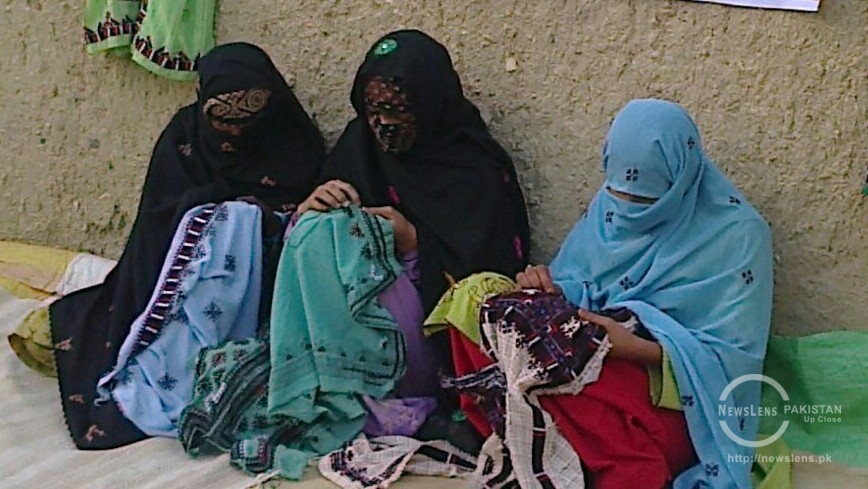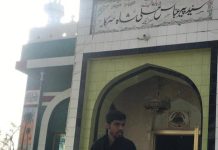
Quetta: Baluchistan, territory-wise the largest province of Pakistan, is enriched with natural resources but is caught up between Baloch insurgency, sectarian violence and Taliban militancy that is making serious impact on the livelihood of laborers and skilled workers.
Experts say the cultural embroidery items of Pashtun and Baloch, if given space in the open market, will both boost up the economic situation of women as they are not encouraged to get an education nor do they have a say in the decision-making process.
Ayesha Gul, 27 left her educational career after graduating from Faculty of Arts (a 12-year formal education) from Government Girls Degree College, Pishin. She and her elder sister, Sakina, joined their hands to learn different skills of embroidery waving including Kandhari, Balochi, Sindhi and other designs of embroidery.
“I left studies because my father couldn’t afford our education and we had no elder brothers to earn, therefore, I thought, vocational training would be an ultimate kind of practical education and a way of earning,” she said while talking to News Lens Pakistan.
Ayesha’s father runs a smaller shop in the street that yields less income due to which Ayesha and her sisters’ keep working on dresses, bed-sheets, dupattas and male as well as female wedding dresses.
Female sale agents bring both the designs and pieces of clothes (male and female), required threads, colors and mirrors. “We complete the work within the deadline. The more hard work we put in with a creative mind, the more value she puts in the piece. I have just prepared a complete dress worthy of PKR 10,000/- in a month,” she added.
The sales agent pays half the amount to the workers whereas the rest goes to the account of the sales agent and the merchant in the market because there are no direct purchasers in Pishin. These pieces would go to Quetta, Islamabad and Karachi’s markets.
“We don’t know how pricy are our embroidery pieces in the market; we only get a smaller portion of its original price; though, we are the soul workers who spend time and energies preparing each piece in weeks and months,” Ayesha said.
Rukhsana Bibi, a sales agent, while talking to News Lens Pakistan said that, like Ayesha, hundreds of girls are working in local and regional embroidery business. “We get orders from the market and make deals with the home-based workers, mostly females, and then take the required orders to local, provincial and national markets,” she said.
Anara Bibi, 18, when asked if she likes going to school instead of doing embroidery, she responded with a smile, “We are not lucky to become doctors or teachers, but we do pass our time with home-based work such as embroidery, cutting and tailoring different designs and earn to feed our family this way.”
Raghia Bibi, a master trainer and sales agent, started the business to take these different cultural pieces to local and regional markets. “I was in Sibbi festival and earned PKR 30,000/- from the pieces I had collected and ordered earlier to the workers,” she said while talking to News Lens Pakistan.
The Pashto and Balochi cultural embroidery is very popular around the regional and western countries. “I even get these pieces of Pashto and Kandhari, Afghani embroidery to the SAARC embroidery stalls in Islamabad’s Lok Virsa, an institute for folk and traditional heritage,” Raghia added.
Abida Kakar, a social and women rights activist while talking to News Lens Pakistan said that the local women were not having space in the national markets. The non-governmental organization made a bridge between them (the workers) and the market.
“I have monitored the situation and now the women send their handmade pieces to different markets and their per-month and per-piece income has increased. Otherwise, they were forced to sell items at lower costs in the local markets,” she said.
Ahsanullah, the local merchant of embroidery on Liaqat Bazar while talking to News Lens Pakistan said, “The Pashtun and Baloch cultural embroidery work is very popular not only in the province but all around Pakistan. We sell the embroidery pieces from PKR 5000/- to PKR 20,000/- in the market.”
Salma Baloch, a social activist, told News Lens Pakistan said that the Baloch women embroidery workers don’t know the exact value of their internationally attracted work. The local shopping malls and middle sale/ purchase agents get huge some of money from the handmade pieces of Balochi culture.
“Our women are talented, skilful but they don’t have open access to the market due to which they are paid with a mere amount and the sales agent gets higher share of the prices of embroidery work”, Aryana Kasi, the Quetta chapter president of Women Chamber of Commerce, told News Lens Pakistan adding that the government should focus on contacting the skilled workers (women) to the open markets. This will ensure the empowerment of Balochi women as well as boost the economy.
Moreover, the social and cultural taboos create hurdles for women to connect with the open market. “Until we overcome these taboos we won’t be having a developed economy in the province because women are half of the men; they should get involved in businesses in the same ratio as men,” she added.
“Only Pishin and Quetta district are connected to the local, regional and national markets. Balochistan’s 32 districts are having resources to prepare embroidery for their own use. If they are connected to the mainstream market, we the masses of Balochistan will be able to generate enough revenue,” says Abida Kakar, a social and women rights activist.
She further said that vocational institutes and awareness are the ways to boost up the embroidery business across Baluchistan. “Both government and social organizations working for women rights and economic stability should get the job done,” she added.
Naseer Ahmed Kakar, who’s a MS student in linguistics while talking to News Lens Pakistan said, “The conflict like situation has diverted our focus from socioeconomic issues to only militancy and insurgency, the distinction of cultural dresses of Pashtun and Baloch being an example”. He further said that no nation can survive unless its language, culture, history are kept preserved.



